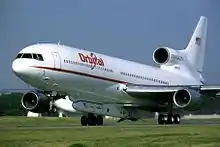Stargazer (aircraft)
The Stargazer is a Lockheed L-1011 TriStar built in 1974, that was modified in 1994 to be used by Orbital Sciences (now part of Northrop Grumman) as a mother ship launch pad for the Pegasus launch vehicle. As of October 2019, 44 rockets (containing 95 satellites) have been launched from it, using the Pegasus-H and Pegasus-XL configurations.[1][2]
| Stargazer | |
|---|---|
.jpg.webp) | |
| Stargazer flying over the Atlantic Ocean carrying a Pegasus XL rocket | |
| Type | Lockheed L-1011 TriStar |
| Registration | N140SC |
| Owners and operators | Orbital Sciences Orbital ATK Northrop Grumman |
| Status | Active |
History
The first Pegasus launch to use Stargazer was conducted on 27 June 1994 as the maiden flight of the Pegasus-XL. Previous launches used the NASA-operated Boeing NB-52B Balls 8, which was also used for four subsequent launches, as the original Pegasus could not be launched from Stargazer due to clearance issues. A modified version, the Pegasus-H, was introduced to rectify this.
Stargazer was also used for captive tests and transportation of the X-34 hypersonic research aircraft; however, drop tests used Balls 8. Orbital Sciences also offer the aircraft for research flights.[3] It is capable of carrying a 23,000 kilograms (51,000 lb) payload to an altitude of 12,800 metres (42,000 ft).[4]

Pegasus launches using Stargazer are usually conducted from Vandenberg Air Force Base. Launches have also been conducted from the Cape Canaveral Air Force Station, the NASA Kennedy Space Center, the NASA Wallops Flight Facility and from launch sites outside the US: Kwajalein Atoll in the Marshall Islands and Gando Airport in Spain.[5]
In 2015, Stargazer was re-painted to reflect Orbital Sciences' merger with Alliant Techsystems.[6]
On 15 December 2016, Stargazer successfully launched CYGNSS on behalf of NASA on its second attempt. The first attempt on 12 December was scrubbed due to issues with the hydraulic system responsible for separating the Pegasus rocket from the launch aircraft.[7]
Stargazer launched the Ionospheric Connection Explorer on 11 October 2019. The launch was originally scheduled for June 2017 but was scrubbed when an anomalous piece of vehicle data was observed during a ferry flight. The data was related to the rudder position of the Pegasus XL rocket and was observed during a routine in-flight vehicle health check.[8] The launch was delayed multiple times throughout 2017 and 2018 and 2019, finally occurring October 11, 2019.[9]
As of October 2019, Stargazer is the only L-1011 aircraft flying.[10]
Background
The Lockheed L-1011 TriStar carrier aircraft first flew in February 1974, and was delivered to Air Canada as C-FTNJ the following month. It was acquired by Orbital Sciences in May 1992 and underwent about a year of modifications.[11] It was renamed for use as carrier aircraft for the Pegasus launch system.[12][8] The company also considered other aircraft including the Boeing B-52G Stratofortress, Boeing 747, and DC-10, considering altitude and speed performance, range, modification complexity, as well as acquisition and operational costs.
See also
| Wikimedia Commons has media related to Stargazer (aircraft). |
References
- "AIRFRAMES.ORG - Aircraft Database - Login". www.airframes.org.
- "Orbital ATK Pegasus". Orbital Sciences Corporation. Retrieved 2018-02-28.
- ""Stargazer" L-1011 Carrier Aircraft". Orbital Sciences Corporation. Retrieved 2009-02-20.
- "L-1011 Fact Sheet" (PDF). Orbital Sciences Corporation. Retrieved 2009-02-20.
- Krebs, Gunter. "Pegasus". Gunter's Space Page. Retrieved 2009-02-20.
- Ray, Justin. "Photo: New Orbital ATK paint job for Pegasus carrier jet". Spaceflight Now. Spaceflight Now Inc. Retrieved 9 June 2016.
- "Hydraulic Pump Glitch Aborts NASA's Hurricane MicroSat Fleet Launch to Dec. 15 - Live Coverage". 13 December 2016.
- "ICON resets for October launch from the East Coast – NASASpaceFlight.com".
- "Launch Schedule – SpaceFlightNow.com".
- https://spaceflightnow.com/2019/10/10/rockets-purchased-by-stratolaunch-back-under-northrop-grumman-control/
- Mosier, Marty. "PEGASUS XL DEVELOPMENT AND L-1011 PEGASUS CARRIER AIRCRAFT".